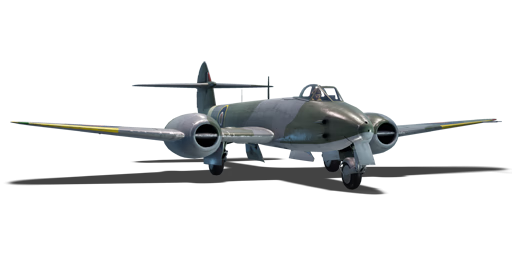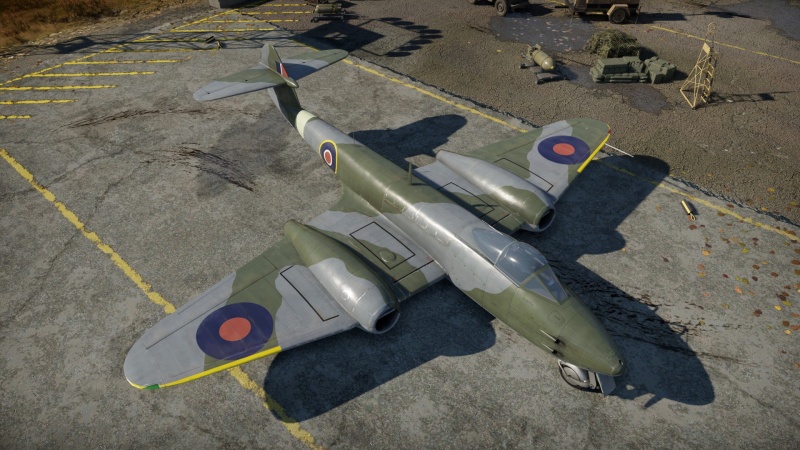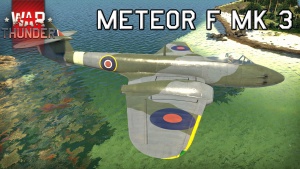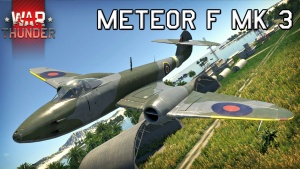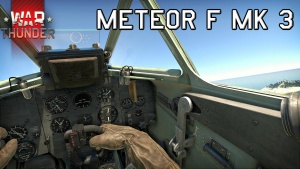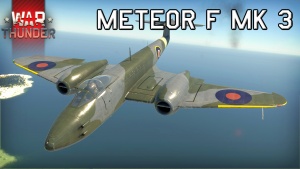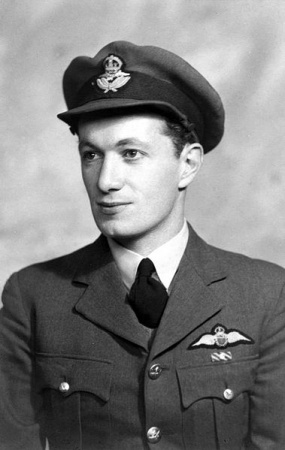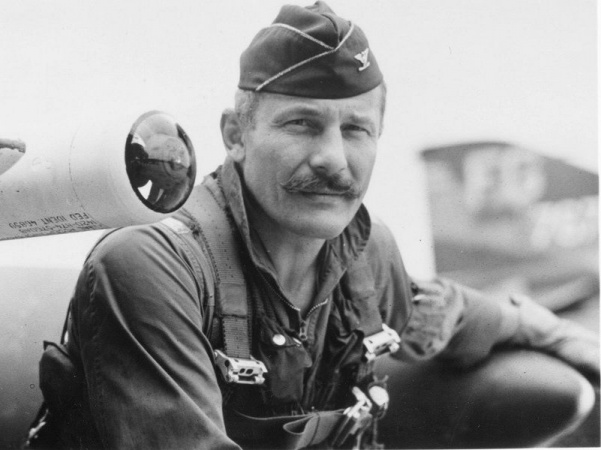Difference between revisions of "Meteor F Mk 3"
m (→History) |
(→Offensive armament: Updated) |
||
| (16 intermediate revisions by 8 users not shown) | |||
| Line 1: | Line 1: | ||
| − | |||
{{About | {{About | ||
| about = British jet fighter '''{{PAGENAME}}''' | | about = British jet fighter '''{{PAGENAME}}''' | ||
| − | | usage = other | + | | usage = other versions |
| link = Meteor (Family) | | link = Meteor (Family) | ||
| + | }} | ||
| + | {{Specs-Card | ||
| + | |code=meteor_fmk3 | ||
| + | |images={{Specs-Card-Image|GarageImage_{{PAGENAME}}.jpg}} | ||
}} | }} | ||
== Description == | == Description == | ||
<!-- ''In the description, the first part should be about the history of and the creation and combat usage of the aircraft, as well as its key features. In the second part, tell the reader about the aircraft in the game. Insert a screenshot of the vehicle, so that if the novice player does not remember the vehicle by name, he will immediately understand what kind of vehicle the article is talking about.'' --> | <!-- ''In the description, the first part should be about the history of and the creation and combat usage of the aircraft, as well as its key features. In the second part, tell the reader about the aircraft in the game. Insert a screenshot of the vehicle, so that if the novice player does not remember the vehicle by name, he will immediately understand what kind of vehicle the article is talking about.'' --> | ||
| − | [[ | + | The Gloster Meteor was the first and only Allied jet aircraft to see combat in WWII. Beginning development in 1940, prototypes first flew in 1943, and the first production variant soon entered service in July 1944. They were initially used to intercept V-1 flying bombs, achieving the world's first air-to-air "kills" in a jet-powered fighter on 4 August, just a few days before its German competitor, the [[Me 262 A-1a|Me 262]], achieved the same on a piloted aircraft. The '''Meteor F Mk 3''', equipped with improved Rolls-Royce Derwent I engines, would enter service in December 1944. They were deployed in Europe, providing air defence over Belgium and the Netherlands, having initially been banned from flying over the continent for fears of being downed and captured by the Germans or Soviets. The Meteor would spawn a number of variants, and would remain in operational service as late as 1970 with export customers such as Argentina. |
| − | + | ||
| − | The ''' | + | In the game since the start of the Open Beta Test prior to Update 1.27, the Meteor F Mk 3 is a solid jack-of-all-trades, and an excellent introduction to early jet combat. While not as fast as the [[Attacker FB 1|Attacker]], nor as manoeuvrable as the [[Vampire F.B.5|Vampire]], the Meteor provides a balanced and versatile platform capable of dogfighting common opponents and adapting to any situation. Its nonetheless excellent manoeuvrability allows it to easily bait and trap most opponents in a turnfight, while the four venerable Hispano cannons mounted in the nose will quickly down any target once on their tail. Its main drawbacks include the somewhat low engine power, as one might expect from one of the first of their kind, as well as the rather stiff roll rate; both issues become greatly alleviated in future variants. |
== General info == | == General info == | ||
=== Flight performance === | === Flight performance === | ||
| − | <!--''Describe how the aircraft behaves in the air. Speed, manoeuvrability, acceleration and allowable loads - these are the most important characteristics of the vehicle.''--> | + | {{Specs-Avia-Flight}} |
| + | <!-- ''Describe how the aircraft behaves in the air. Speed, manoeuvrability, acceleration and allowable loads - these are the most important characteristics of the vehicle.'' --> | ||
{| class="wikitable" style="text-align:center" width="70%" | {| class="wikitable" style="text-align:center" width="70%" | ||
| Line 56: | Line 60: | ||
! Combat !! Take-off !! Landing !! + !! - | ! Combat !! Take-off !! Landing !! + !! - | ||
|- | |- | ||
| − | | {{Specs|destruction|body}} || {{Specs|destruction|gear}} || | + | | 850 <!-- {{Specs|destruction|body}} --> || {{Specs|destruction|gear}} || 495 || 462 || 290 || ~9 || ~4 |
|- | |- | ||
|} | |} | ||
| Line 74: | Line 78: | ||
|- | |- | ||
! colspan="3" | Engine | ! colspan="3" | Engine | ||
| − | ! colspan=" | + | ! colspan="5" | Aircraft mass |
|- | |- | ||
! colspan="2" | Engine name || Number | ! colspan="2" | Engine name || Number | ||
| − | ! colspan="2" | | + | ! colspan="2" | {{Annotation|Basic mass|Mass of the aircraft with pilot and engine oil, but no fuel or weapons load}} || colspan="3" | Wing loading (full fuel) |
|- | |- | ||
| − | | colspan="2" | Rolls-Royce Derwent | + | | colspan="2" | Rolls-Royce Derwent || 2 |
| − | | colspan="2" | 4, | + | | colspan="2" | 4,393 kg || colspan="3" | 161 kg/m<sup>2</sup> |
|- | |- | ||
! colspan="3" | Engine characteristics | ! colspan="3" | Engine characteristics | ||
| − | ! colspan=" | + | ! colspan="4" | Mass with fuel (no weapons load) || rowspan="2" | Max Takeoff<br>Weight |
|- | |- | ||
! Weight (each) || colspan="2" | Type | ! Weight (each) || colspan="2" | Type | ||
| − | ! | + | ! 10m fuel || 20m fuel || 30m fuel || 34m fuel |
|- | |- | ||
| 443 kg || colspan="2" | Centrifugal-flow turbojet | | 443 kg || colspan="2" | Centrifugal-flow turbojet | ||
| − | | 4, | + | | 4,753 kg || 5,095 kg || 5,446 kg || 5,593 kg || 5,820 kg |
|- | |- | ||
| − | ! colspan="3" | {{Annotation|Maximum engine thrust @ 0 m (RB / SB)|The maximum thrust produced by each engine, while mounted in the aircraft. NOTE: Thrust varies significantly depending on speed & altitude.}} | + | ! colspan="3" | {{Annotation|Maximum engine thrust @ 0 m (RB/SB)|The maximum thrust produced by each engine, while mounted in the aircraft. NOTE: Thrust varies significantly depending on speed & altitude.}} |
| − | ! colspan=" | + | ! colspan="5" | Thrust to weight ratio @ 0 m (109%) |
|- | |- | ||
! Condition || 100% || 109% | ! Condition || 100% || 109% | ||
| − | ! | + | ! 10m fuel || 20m fuel || 30m fuel || 34m fuel || MTOW |
|- | |- | ||
| ''Stationary'' || 900 kgf || 990 kgf | | ''Stationary'' || 900 kgf || 990 kgf | ||
| − | | 0. | + | | 0.42 || 0.39 || 0.36 || 0.35 || 0.34 |
|- | |- | ||
| − | | ''Optimal'' || 900 kgf<br | + | | ''Optimal'' || 900 kgf<br>(0 km/h) || 990 kgf<br>(0 km/h) |
| − | | 0. | + | | 0.42 || 0.39 || 0.36 || 0.35 || 0.34 |
|- | |- | ||
|} | |} | ||
| Line 108: | Line 112: | ||
=== Survivability and armour === | === Survivability and armour === | ||
| + | {{Specs-Avia-Armour}} | ||
<!-- ''Examine the survivability of the aircraft. Note how vulnerable the structure is and how secure the pilot is, whether the fuel tanks are armoured, etc. Describe the armour, if there is any, and also mention the vulnerability of other critical aircraft systems.'' --> | <!-- ''Examine the survivability of the aircraft. Note how vulnerable the structure is and how secure the pilot is, whether the fuel tanks are armoured, etc. Describe the armour, if there is any, and also mention the vulnerability of other critical aircraft systems.'' --> | ||
| Line 114: | Line 119: | ||
* 12.7 mm Steel plate in the nose. | * 12.7 mm Steel plate in the nose. | ||
* Critical components located at the front and in the wings of the aircraft (fuel, pilot, engine, controls) | * Critical components located at the front and in the wings of the aircraft (fuel, pilot, engine, controls) | ||
| + | |||
| + | === Modifications and economy === | ||
| + | {{Specs-Economy}} | ||
== Armaments == | == Armaments == | ||
| + | {{Specs-Avia-Armaments}} | ||
=== Offensive armament === | === Offensive armament === | ||
| + | {{Specs-Avia-Offensive}} | ||
<!-- ''Describe the offensive armament of the aircraft, if any. Describe how effective the cannons and machine guns are in a battle, and also what belts or drums are better to use. If there is no offensive weaponry, delete this subsection.'' --> | <!-- ''Describe the offensive armament of the aircraft, if any. Describe how effective the cannons and machine guns are in a battle, and also what belts or drums are better to use. If there is no offensive weaponry, delete this subsection.'' --> | ||
| − | {{main|Hispano Mk. | + | {{main|Hispano Mk.II (20 mm)}} |
The '''''{{PAGENAME}}''''' is armed with: | The '''''{{PAGENAME}}''''' is armed with: | ||
| − | * 4 x 20 mm Hispano Mk. | + | * 4 x 20 mm Hispano Mk.II cannons, nose-mounted (180 rpg = 720 total) |
| + | |||
| + | === Suspended armament === | ||
| + | {{Specs-Avia-Suspended}} | ||
| + | <!-- ''Describe the aircraft's suspended armament: additional cannons under the wings, bombs, rockets and torpedoes. This section is especially important for bombers and attackers. If there is no suspended weaponry remove this subsection.'' --> | ||
| + | {{main|H.E. M.C. Mk.13 (1,000 lb)}} | ||
| + | |||
| + | The '''''{{PAGENAME}}''''' can be outfitted with the following ordnance: | ||
| + | |||
| + | * Without load | ||
| + | * 2 x 1,000 lb H.E. M.C. Mk.13 bombs (2,000 lb total) | ||
== Usage in battles == | == Usage in battles == | ||
| − | + | <!-- ''Describe the tactics of playing in the aircraft, the features of using aircraft in a team and advice on tactics. Refrain from creating a "guide" - do not impose a single point of view, but instead, give the reader food for thought. Examine the most dangerous enemies and give recommendations on fighting them. If necessary, note the specifics of the game in different modes (AB, RB, SB).'' --> | |
| + | [[File:Meteor III Screenshot 2.jpg|thumb]] | ||
The toughest enemies to fight in the Meteor F Mk 3 are perhaps the [[Ki-200]], [[Me 163 B|Me 163]], and [[Ho 229 V3|Ho 229]]. These aircraft are faster and have better acceleration. | The toughest enemies to fight in the Meteor F Mk 3 are perhaps the [[Ki-200]], [[Me 163 B|Me 163]], and [[Ho 229 V3|Ho 229]]. These aircraft are faster and have better acceleration. | ||
| Line 135: | Line 156: | ||
If the enemy is smart enough to dive and gather a little more speed for extra manoeuvrability, go up instead and roll over the enemy. If the enemy goes up, go up with it but be prepared for a hammerhead attack. If one does come, roll yourself over to provide the minimum surface area that he can attack and pitch down to the earth (to gather a little more speed for extra manoeuvrability). Continue doing this until the rocket plane gives up or runs out of fuel. | If the enemy is smart enough to dive and gather a little more speed for extra manoeuvrability, go up instead and roll over the enemy. If the enemy goes up, go up with it but be prepared for a hammerhead attack. If one does come, roll yourself over to provide the minimum surface area that he can attack and pitch down to the earth (to gather a little more speed for extra manoeuvrability). Continue doing this until the rocket plane gives up or runs out of fuel. | ||
| − | Do not chase the rocket plane directly if it decides to flee, but climb slightly faster than the best rate of climb (approximately 190 knots/350 | + | Do not chase the rocket plane directly if it decides to flee, but climb slightly faster than the best rate of climb (approximately 190 knots / 350 km/h / 220 mph) and if he flies directly overhead for the strike, simply perform a shallow dive and pull a horizontal turn to ruin their approach. Continue doing this until they run out of fuel. |
| − | |||
| − | |||
| − | |||
| − | |||
| − | |||
| − | |||
| − | |||
| − | |||
| − | |||
| − | |||
| − | |||
| − | |||
| − | |||
| − | |||
| − | |||
| − | |||
| − | |||
| − | |||
| − | |||
| − | |||
| − | |||
| − | |||
| − | |||
| − | |||
| − | |||
| − | |||
| − | |||
| − | |||
| − | |||
| − | |||
| − | |||
| − | |||
| − | |||
=== Pros and cons === | === Pros and cons === | ||
| Line 176: | Line 164: | ||
* Good turn rate | * Good turn rate | ||
| − | |||
| − | |||
* Decent climb rate and energy retention | * Decent climb rate and energy retention | ||
* Decent manoeuvrability at low speeds | * Decent manoeuvrability at low speeds | ||
| + | * Good acceleration for an early jet | ||
| + | * Useful airbrakes, hard to rip the wings if you use them correctly | ||
| + | * Can limp back to the airfield on one engine | ||
| + | * The 4 x 20 mm cannons are accurate | ||
| + | * Effective air targets ammo belt | ||
'''Cons:''' | '''Cons:''' | ||
| Line 189: | Line 180: | ||
== History == | == History == | ||
| + | <!-- ''Describe the history of the creation and combat usage of the aircraft in more detail than in the introduction. If the historical reference turns out to be too long, take it to a separate article, taking a link to the article about the vehicle and adding a block "/History" (example: <nowiki>https://wiki.warthunder.com/(Vehicle-name)/History</nowiki>) and add a link to it here using the <code>main</code> template. Be sure to reference text and sources by using <code><nowiki><ref></ref></nowiki></code>, as well as adding them at the end of the article with <code><nowiki><references /></nowiki></code>. This section may also include the vehicle's dev blog entry (if applicable) and the in-game encyclopedia description (under <code><nowiki>=== In-game description ===</nowiki></code>, also if applicable).'' --> | ||
[[File:Meteor III Screenshot 1.jpg|thumb|Cockpit of the Meteor Mk 3]] | [[File:Meteor III Screenshot 1.jpg|thumb|Cockpit of the Meteor Mk 3]] | ||
| − | |||
| − | The Gloster Meteor F Mk 3 was the first version of the Meteor to be produced in large numbers, the Mk 3 was significantly heavier than the previous versions of the Meteor, however, it also improved the performance dramatically, the first prototype for the Mk 3 specification (DG209) first flew on the 18th April 1944 and immediately demonstrated its performance improvement by reaching | + | The Gloster Meteor F Mk 3 was the first version of the Meteor to be produced in large numbers, the Mk 3 was significantly heavier than the previous versions of the Meteor, however, it also improved the performance dramatically, the first prototype for the Mk 3 specification (DG209) first flew on the 18th April 1944 and immediately demonstrated its performance improvement by reaching 465 mph (748 km/h) at 16,000 ft, this demonstrated a clear performance improvement over the Meteor Mk 1. The initial 15 aircraft of Mk 3 production were fitted with earlier Rolls Royce W.2B/23c Welland powerplant which was carried over from the Meteor Mk 1, these first 15 airframes of course had reduced performance due to these earlier powerplants being used, shortly after production started the Rolls-Royce Derwent I powerplant became available, this engine increased the power to 2,000 lb of thrust per engine, this was the most common powerplant for the Mk 3, although later in the production run examples were fitted with the later Derwent IV engine which increased thrust to 2,400 lb per engine, giving yet another performance improvement. The final 15 production models were fitted with extended engine nacelles in common with those developed for the later Meteor Mk 4, these increased the performance of the aircraft yet again, this would mark the final major modification to the Mk 3 design before the Meteor Mk 4 would begin production. |
The Meteor Mk 3 was used operationally by No.616 and 504 squadrons during WW2, although they were only used in action by 616 squadron, during the closing months of the war in Europe the Meteor Mk 3 was used by No.616 squadron for armed reconnaissance and ground attack, it was hoped that the Meteor would encounter the Messerschmitt 262 and be able to demonstrate its superior performance, although this confrontation never took place. In the immediate post-war years the Meteor Mk 3 served as the primary fighter for the RAF, until it was replaced by the improved Meteor Mk 4 in mid 1947. | The Meteor Mk 3 was used operationally by No.616 and 504 squadrons during WW2, although they were only used in action by 616 squadron, during the closing months of the war in Europe the Meteor Mk 3 was used by No.616 squadron for armed reconnaissance and ground attack, it was hoped that the Meteor would encounter the Messerschmitt 262 and be able to demonstrate its superior performance, although this confrontation never took place. In the immediate post-war years the Meteor Mk 3 served as the primary fighter for the RAF, until it was replaced by the improved Meteor Mk 4 in mid 1947. | ||
| − | + | {{break}} | |
| + | {{Navigation-Start|{{Annotation|Archive of the in-game description|An archive of the historical description of the vehicle that was presented in-game prior to Update 1.55 'Royal Armour'}}}} | ||
| + | {{Navigation-First-Simple-Line}} | ||
The Gloster Meteor was the RAF's first jet powered aircraft, and the only Allied jet to see combat in the Second World War. An all-metal, single-seat fighter with two turbojet engines, it first entered service in 1944. The aircraft's development started in August 1940 and was given Air Ministry approval in November of the same year. The Ministry of Aircraft Production drew up the official F.9/40 specifications for a heavy interceptor fighter to be designated as Type G.41; the first prototype fighter flew on March 5th 1943 at RAF Cranwell. At the beginning of 1944, the aircraft was launched into full-scale production under the designation of Gloster Meteor F.Mk.I (Type G.41A). The type entered service with No 616 Squadron who, after conversion to the Meteor from their Spitfire Mk.VIIs, used the ground breaking fighter to successfully intercept V-1 'flying bombs' which were being launched from bases in occupied Europe to attack targets in England. | The Gloster Meteor was the RAF's first jet powered aircraft, and the only Allied jet to see combat in the Second World War. An all-metal, single-seat fighter with two turbojet engines, it first entered service in 1944. The aircraft's development started in August 1940 and was given Air Ministry approval in November of the same year. The Ministry of Aircraft Production drew up the official F.9/40 specifications for a heavy interceptor fighter to be designated as Type G.41; the first prototype fighter flew on March 5th 1943 at RAF Cranwell. At the beginning of 1944, the aircraft was launched into full-scale production under the designation of Gloster Meteor F.Mk.I (Type G.41A). The type entered service with No 616 Squadron who, after conversion to the Meteor from their Spitfire Mk.VIIs, used the ground breaking fighter to successfully intercept V-1 'flying bombs' which were being launched from bases in occupied Europe to attack targets in England. | ||
The Gloster Meteor F.Mk.III fighter that entered service in August 1944 became the first full-scale production version of the aircraft. The F.Mk.III version was powered by two Rolls-Royce Derwent Mk.I turbojet engines producing 910 kg of thrust. Furthermore, a number of changes were introduced in the design: the dive flaps were improved, the fuel quantity was increased, and the airframe was partially reinforced. Externally, the F.Mk.III differed from the F.Mk.I by its new cockpit canopy, which was not side-opening but sliding. | The Gloster Meteor F.Mk.III fighter that entered service in August 1944 became the first full-scale production version of the aircraft. The F.Mk.III version was powered by two Rolls-Royce Derwent Mk.I turbojet engines producing 910 kg of thrust. Furthermore, a number of changes were introduced in the design: the dive flaps were improved, the fuel quantity was increased, and the airframe was partially reinforced. Externally, the F.Mk.III differed from the F.Mk.I by its new cockpit canopy, which was not side-opening but sliding. | ||
[[File:Meteor III Screenshot 4.jpg|thumb]] | [[File:Meteor III Screenshot 4.jpg|thumb]] | ||
| − | The fighter's armament consisted of four | + | The fighter's armament consisted of four 20 mm British Hispano Mk.II cannons with 200 rounds per gun in the upper pair and 190 rounds per gun in the lower pair. |
| − | A 180-gallon (818 L) fuel tank could be suspended under the fuselage. Two 100 | + | A 180-gallon (818 L) fuel tank could be suspended under the fuselage. Two 100 gallon (455 l) external fuel tanks could also be mounted under the wing panels. As an experiment, the suspension of two 500 lb (227 kg) or 1,000 lb (454 kg) bombs or 16 rockets was attempted. |
The first F.Mk.III fighters produced in September 1944 had Rolls-Royce Welland engines producing 770 kg of thrust, as the Rolls-Royce Derwents were not yet mass-produced. These aircraft were designated as the G.41C. The 16th and subsequent production aircraft were the first to have standard Derwent Mk.I engines; these were designated as the G.41D. The last 15 production aircraft assembled were the G.41E version, with extended nacelles designed for the subsequent version of the F.Mk.4. | The first F.Mk.III fighters produced in September 1944 had Rolls-Royce Welland engines producing 770 kg of thrust, as the Rolls-Royce Derwents were not yet mass-produced. These aircraft were designated as the G.41C. The 16th and subsequent production aircraft were the first to have standard Derwent Mk.I engines; these were designated as the G.41D. The last 15 production aircraft assembled were the G.41E version, with extended nacelles designed for the subsequent version of the F.Mk.4. | ||
| Line 212: | Line 205: | ||
The total number of F.Mk.III Gloster Meteors built was 210, but service after the end of the Second World War would see further development and operational sorties in combat. | The total number of F.Mk.III Gloster Meteors built was 210, but service after the end of the Second World War would see further development and operational sorties in combat. | ||
| + | {{Navigation-End}} | ||
=== Notable pilots === | === Notable pilots === | ||
| + | <gallery mode="packed" heights="300"> | ||
| + | File:John_Plagis_portrait.jpg|link=User:U64962917#Plagis,_Ioannis_"John"_A.|Top scoring Southern Rhodesian ace pilot [[User:U64962917#Plagis,_Ioannis_"John"_A.|John Plagis]] and highest scoring pilot of Greek origin of WW II. Plagis flew the Meteor for several years after the end of WW II. | ||
| + | File:Robin_Olds_portrait.jpg|link=User:U64962917#Olds,_Robin.|In 1948, [[User:U64962917#Olds, Robin|Robin Olds]] transferred to England under the USAF/RAF exchange program where he flew the Gloster Meteor jet fighter and commanded the No. 1 Squadron at R.A.F. Tangmere. | ||
| + | </gallery> | ||
| − | + | == Media == | |
| − | < | + | <!-- ''Excellent additions to the article would be video guides, screenshots from the game, and photos.'' --> |
| − | |||
| − | |||
| − | |||
| − | |||
| − | = | + | ;Skins |
| − | + | ||
| + | * [https://live.warthunder.com/feed/camouflages/?vehicle=meteor_fmk3 Skins and camouflages for the {{PAGENAME}} from live.warthunder.com.] | ||
== See also == | == See also == | ||
| Line 232: | Line 227: | ||
== External links == | == External links == | ||
| − | ''Paste links to sources and external resources, such as:'' | + | <!-- ''Paste links to sources and external resources, such as:'' |
| + | * ''topic on the official game forum;'' | ||
| + | * ''other literature.'' --> | ||
| − | * | + | * [https://forum.warthunder.com/index.php?/topic/264989-gloster-meteor-f-mk3/ Official data sheet - more details about the performance] |
| − | |||
| − | |||
{{AirManufacturer Gloster}} | {{AirManufacturer Gloster}} | ||
{{Britain jet aircraft}} | {{Britain jet aircraft}} | ||
Latest revision as of 15:21, 22 June 2024
| This page is about the British jet fighter Meteor F Mk 3. For other versions, see Meteor (Family). |
Contents
Description
The Gloster Meteor was the first and only Allied jet aircraft to see combat in WWII. Beginning development in 1940, prototypes first flew in 1943, and the first production variant soon entered service in July 1944. They were initially used to intercept V-1 flying bombs, achieving the world's first air-to-air "kills" in a jet-powered fighter on 4 August, just a few days before its German competitor, the Me 262, achieved the same on a piloted aircraft. The Meteor F Mk 3, equipped with improved Rolls-Royce Derwent I engines, would enter service in December 1944. They were deployed in Europe, providing air defence over Belgium and the Netherlands, having initially been banned from flying over the continent for fears of being downed and captured by the Germans or Soviets. The Meteor would spawn a number of variants, and would remain in operational service as late as 1970 with export customers such as Argentina.
In the game since the start of the Open Beta Test prior to Update 1.27, the Meteor F Mk 3 is a solid jack-of-all-trades, and an excellent introduction to early jet combat. While not as fast as the Attacker, nor as manoeuvrable as the Vampire, the Meteor provides a balanced and versatile platform capable of dogfighting common opponents and adapting to any situation. Its nonetheless excellent manoeuvrability allows it to easily bait and trap most opponents in a turnfight, while the four venerable Hispano cannons mounted in the nose will quickly down any target once on their tail. Its main drawbacks include the somewhat low engine power, as one might expect from one of the first of their kind, as well as the rather stiff roll rate; both issues become greatly alleviated in future variants.
General info
Flight performance
| Characteristics | Max Speed (km/h at 6,096 m) |
Max altitude (metres) |
Turn time (seconds) |
Rate of climb (metres/second) |
Take-off run (metres) | |||
|---|---|---|---|---|---|---|---|---|
| AB | RB | AB | RB | AB | RB | |||
| Stock | 719 | 694 | 12500 | 20.9 | 21.5 | 17.9 | 16.7 | 550 |
| Upgraded | 795 | 755 | 19.6 | 20.0 | 27.7 | 22.5 | ||
Details
| Features | |||||
|---|---|---|---|---|---|
| Combat flaps | Take-off flaps | Landing flaps | Air brakes | Arrestor gear | Drogue chute |
| ✓ | ✓ | ✓ | ✓ | X | X |
| Limits | ||||||
|---|---|---|---|---|---|---|
| Wings (km/h) | Gear (km/h) | Flaps (km/h) | Max Static G | |||
| Combat | Take-off | Landing | + | - | ||
| 850 | 390 | 495 | 462 | 290 | ~9 | ~4 |
| Optimal velocities (km/h) | |||
|---|---|---|---|
| Ailerons | Rudder | Elevators | Radiator |
| < 450 | < 600 | < 520 | N/A |
Engine performance
| Engine | Aircraft mass | ||||||
|---|---|---|---|---|---|---|---|
| Engine name | Number | Basic mass | Wing loading (full fuel) | ||||
| Rolls-Royce Derwent | 2 | 4,393 kg | 161 kg/m2 | ||||
| Engine characteristics | Mass with fuel (no weapons load) | Max Takeoff Weight | |||||
| Weight (each) | Type | 10m fuel | 20m fuel | 30m fuel | 34m fuel | ||
| 443 kg | Centrifugal-flow turbojet | 4,753 kg | 5,095 kg | 5,446 kg | 5,593 kg | 5,820 kg | |
| Maximum engine thrust @ 0 m (RB/SB) | Thrust to weight ratio @ 0 m (109%) | ||||||
| Condition | 100% | 109% | 10m fuel | 20m fuel | 30m fuel | 34m fuel | MTOW |
| Stationary | 900 kgf | 990 kgf | 0.42 | 0.39 | 0.36 | 0.35 | 0.34 |
| Optimal | 900 kgf (0 km/h) |
990 kgf (0 km/h) |
0.42 | 0.39 | 0.36 | 0.35 | 0.34 |
Survivability and armour
- 38 mm Bulletproof glass in cockpit front.
- 12.7 mm Steel plate behind the pilot.
- 12.7 mm Steel plate in the nose.
- Critical components located at the front and in the wings of the aircraft (fuel, pilot, engine, controls)
Modifications and economy
Armaments
Offensive armament
The Meteor F Mk 3 is armed with:
- 4 x 20 mm Hispano Mk.II cannons, nose-mounted (180 rpg = 720 total)
Suspended armament
The Meteor F Mk 3 can be outfitted with the following ordnance:
- Without load
- 2 x 1,000 lb H.E. M.C. Mk.13 bombs (2,000 lb total)
Usage in battles
The toughest enemies to fight in the Meteor F Mk 3 are perhaps the Ki-200, Me 163, and Ho 229. These aircraft are faster and have better acceleration.
To combat a Ho 229: the flying wing has a worse roll rate than the Meteor so scissors are the best way to counter them. A split-S or an Immelmann is not recommended as the Ho 229 has better energy retention.
The Me 163B and the Ki-200 are in theory easier to fight since the main priority is to simply survive long enough that they run out of fuel. The Mark 3 has a higher wing lift to mass ratio. Thus, it can barely out-turn the rocket planes (even with their rocket engines enabled), but this is very dangerous and only the better-skilled pilot will come out of a turn fight alive.
If the enemy is smart enough to dive and gather a little more speed for extra manoeuvrability, go up instead and roll over the enemy. If the enemy goes up, go up with it but be prepared for a hammerhead attack. If one does come, roll yourself over to provide the minimum surface area that he can attack and pitch down to the earth (to gather a little more speed for extra manoeuvrability). Continue doing this until the rocket plane gives up or runs out of fuel.
Do not chase the rocket plane directly if it decides to flee, but climb slightly faster than the best rate of climb (approximately 190 knots / 350 km/h / 220 mph) and if he flies directly overhead for the strike, simply perform a shallow dive and pull a horizontal turn to ruin their approach. Continue doing this until they run out of fuel.
Pros and cons
Pros:
- Good turn rate
- Decent climb rate and energy retention
- Decent manoeuvrability at low speeds
- Good acceleration for an early jet
- Useful airbrakes, hard to rip the wings if you use them correctly
- Can limp back to the airfield on one engine
- The 4 x 20 mm cannons are accurate
- Effective air targets ammo belt
Cons:
- Low top speed
- Easily rips wings (500 mph+)
- Below average roll rate
- Poor rear cockpit visibility in Sim battles (hurts when performing scissors)
History
The Gloster Meteor F Mk 3 was the first version of the Meteor to be produced in large numbers, the Mk 3 was significantly heavier than the previous versions of the Meteor, however, it also improved the performance dramatically, the first prototype for the Mk 3 specification (DG209) first flew on the 18th April 1944 and immediately demonstrated its performance improvement by reaching 465 mph (748 km/h) at 16,000 ft, this demonstrated a clear performance improvement over the Meteor Mk 1. The initial 15 aircraft of Mk 3 production were fitted with earlier Rolls Royce W.2B/23c Welland powerplant which was carried over from the Meteor Mk 1, these first 15 airframes of course had reduced performance due to these earlier powerplants being used, shortly after production started the Rolls-Royce Derwent I powerplant became available, this engine increased the power to 2,000 lb of thrust per engine, this was the most common powerplant for the Mk 3, although later in the production run examples were fitted with the later Derwent IV engine which increased thrust to 2,400 lb per engine, giving yet another performance improvement. The final 15 production models were fitted with extended engine nacelles in common with those developed for the later Meteor Mk 4, these increased the performance of the aircraft yet again, this would mark the final major modification to the Mk 3 design before the Meteor Mk 4 would begin production.
The Meteor Mk 3 was used operationally by No.616 and 504 squadrons during WW2, although they were only used in action by 616 squadron, during the closing months of the war in Europe the Meteor Mk 3 was used by No.616 squadron for armed reconnaissance and ground attack, it was hoped that the Meteor would encounter the Messerschmitt 262 and be able to demonstrate its superior performance, although this confrontation never took place. In the immediate post-war years the Meteor Mk 3 served as the primary fighter for the RAF, until it was replaced by the improved Meteor Mk 4 in mid 1947.
| Archive of the in-game description | |
|---|---|
|
The Gloster Meteor was the RAF's first jet powered aircraft, and the only Allied jet to see combat in the Second World War. An all-metal, single-seat fighter with two turbojet engines, it first entered service in 1944. The aircraft's development started in August 1940 and was given Air Ministry approval in November of the same year. The Ministry of Aircraft Production drew up the official F.9/40 specifications for a heavy interceptor fighter to be designated as Type G.41; the first prototype fighter flew on March 5th 1943 at RAF Cranwell. At the beginning of 1944, the aircraft was launched into full-scale production under the designation of Gloster Meteor F.Mk.I (Type G.41A). The type entered service with No 616 Squadron who, after conversion to the Meteor from their Spitfire Mk.VIIs, used the ground breaking fighter to successfully intercept V-1 'flying bombs' which were being launched from bases in occupied Europe to attack targets in England. The Gloster Meteor F.Mk.III fighter that entered service in August 1944 became the first full-scale production version of the aircraft. The F.Mk.III version was powered by two Rolls-Royce Derwent Mk.I turbojet engines producing 910 kg of thrust. Furthermore, a number of changes were introduced in the design: the dive flaps were improved, the fuel quantity was increased, and the airframe was partially reinforced. Externally, the F.Mk.III differed from the F.Mk.I by its new cockpit canopy, which was not side-opening but sliding. The fighter's armament consisted of four 20 mm British Hispano Mk.II cannons with 200 rounds per gun in the upper pair and 190 rounds per gun in the lower pair. A 180-gallon (818 L) fuel tank could be suspended under the fuselage. Two 100 gallon (455 l) external fuel tanks could also be mounted under the wing panels. As an experiment, the suspension of two 500 lb (227 kg) or 1,000 lb (454 kg) bombs or 16 rockets was attempted. The first F.Mk.III fighters produced in September 1944 had Rolls-Royce Welland engines producing 770 kg of thrust, as the Rolls-Royce Derwents were not yet mass-produced. These aircraft were designated as the G.41C. The 16th and subsequent production aircraft were the first to have standard Derwent Mk.I engines; these were designated as the G.41D. The last 15 production aircraft assembled were the G.41E version, with extended nacelles designed for the subsequent version of the F.Mk.4. In 1948, two production aircraft were converted to the Gloster (Sea) Meteor F.Mk.3 version for Royal Navy test flights from aircraft carriers. The fighters had their armament removed, a landing hook fitted, and the gear legs reinforced. The Derwent Mk.1 engines were replaced with Derwent Mk.5 models. These aircraft performed 32 landings on board HMS Illustrious. The Gloster Meteor was the first British production jet fighter and the only Allied jet aircraft to take part in World War II. The first F.Mk.IIIs were delivered to the front in the end of January 1945. Jet aircraft were considered to be secret and, as a result, a great number of limitations were imposed on their combat use. This included a complete withdrawal of permission to operate over German held territory in case the revolutionary technology was captured by the enemy. Meteors did eventually operate out of Belgium as part of the 2nd Tactical Air Force, where they were employed in ground attack and reconnaissance missions. The total number of F.Mk.III Gloster Meteors built was 210, but service after the end of the Second World War would see further development and operational sorties in combat. | |
Notable pilots
Top scoring Southern Rhodesian ace pilot John Plagis and highest scoring pilot of Greek origin of WW II. Plagis flew the Meteor for several years after the end of WW II.
In 1948, Robin Olds transferred to England under the USAF/RAF exchange program where he flew the Gloster Meteor jet fighter and commanded the No. 1 Squadron at R.A.F. Tangmere.
Media
- Skins
See also
Links to the articles on the War Thunder Wiki that you think will be useful for the reader, for example:
- reference to the series of the aircraft;
- links to approximate analogues of other nations and research trees.
External links
| Gloster Aircraft Company, Limited | |
|---|---|
| Fighters | Gladiator Mk II · Sea Gladiator Mk I · Gladiator Mk IIF · Gladiator Mk IIS · Tuck's Gladiator Mk II |
| Jet Fighters | Meteor F Mk 3 · Sea Meteor F Mk 3 · Meteor F Mk 4 G.41F · Meteor F Mk 4 G.41G · Meteor F Mk 8 G.41K · Meteor F Mk.8 Reaper |
| Javelin F.(A.W.) Mk.9 | |
| Export | J8A · Iacobi's J8A · ␗Gladiator Mk I · ▄Gladiator Mk I |
| ▄Meteor F Mk.8 · Meteor F.8 · Meteor NF.13 | |
| See Also | Fokker |
| Britain jet aircraft | |
|---|---|
| Blackburn | Buccaneer S.1 · Buccaneer S.2 · Buccaneer S.2B |
| British Aerospace | Harrier GR.7 · Sea Harrier FRS.1 (e) · Sea Harrier FRS.1 · Sea Harrier FA 2 |
| British Aircraft Corporation | Strikemaster Mk.88 |
| English Electric | Canberra B Mk 2 · Canberra B (I) Mk 6 · Lightning F.6 · Lightning F.53 |
| Gloster | Meteor F Mk 3 · Sea Meteor F Mk 3 · Meteor F Mk 4 G.41F · Meteor F Mk 4 G.41G · Meteor F Mk 8 G.41K · Meteor F Mk.8 Reaper |
| Javelin F.(A.W.) Mk.9 | |
| de Havilland | Vampire F.B.5 · Venom FB.4 · Sea Venom FAW 20 · Sea Vixen F.A.W. Mk.2 |
| Hawker | Sea Hawk FGA.6 · Hunter F.1 · Hunter F.6 · Hunter FGA.9 · Harrier GR.1 · Harrier GR.3 |
| Panavia | Tornado GR.1 · Tornado GR.4 · Tornado F.3 · Tornado F.3 Late |
| SEPECAT | Jaguar GR.1 · Jaguar GR.1A · Jaguar IS |
| Supermarine | Attacker FB 1 · Attacker FB.2 · Scimitar F Mk.1 · Swift F.1 · Swift F.7 |
| Foreign | Phantom FG.1 (USA) · Phantom FGR.2 (USA) · F-4J(UK) Phantom II (USA) |
| Australia | F-111C |
| India | ▄MiG-21 Bison |
| South Africa | ▄JAS39C |


